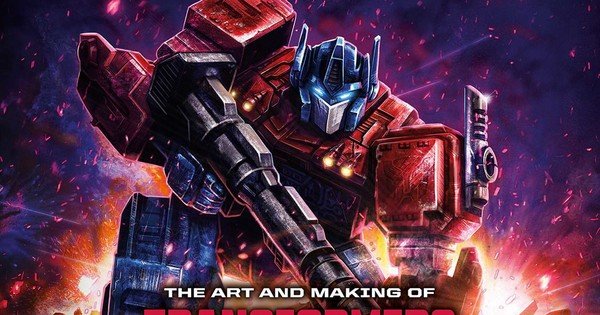The fun of art books is seeing the evolution of your favorite characters: where their design came from, what changed and when, and how things arrived at the state you eventually saw on the silver screen. The Art and Making of Transformers: War for Cybertron Trilogy is more than that: not content with just compiling all of the production art for the show, it is a full chronology of the production history of the Siege, Earthrise and Kingdom Transformers anime. In that regard, I can’t review this as an art book—because this book simply isn’t an art book. It’s a story. It’s nevertheless a difficult story to review, being that it’s all about the production of a show.
The story begins with the concept pitches within Hasbro, weighing the idea of a Transformers show that serves as a prequel to the original 1980s series. While this story angle has been explored lightly in the comics, it’s never one that fans have been able to see in animation before. Eventually, Hasbro‘s team is able to connect with Netflix and Studio Polygon, where the idea is fleshed out, characters are chosen, and the path is laid for the reintroduction of the Beast Wars cast in time for their 25th anniversary.
It’s a story we see from all of the later stages: the conceptualization of key characters and their redesigns, the reasoning behind certain plot choices and character actions, the evolution of the world of Cybertron as it exists in this anime, and a brief look at the people who brought the series to life. While it’s expected to have executives and producers weighing in and offering promo-speak to promote the show, there is also a look at many of the people on the ground floor who handled the nuts and bolts of the show. Special mention is given to key staff members like Polygon’s Suichi Kohno, who was responsible for figuring out the physics of the conversion processes for the individual characters based on their toys.
Special attention is given to each and every detail over the course of production; for example, the many rank insignias for the cast are explained, and the Quintesson Deseeus’s emblem is broken down to demonstrate its individual components and what they represent. There’s also a whole chapter dedicated to the worldbuilding, demonstrating little details from the series from in-universe propaganda posters made by the Autobots and Decepticons to some insight on the musical score. And of course, there’s a gallery of all the toy-versions of the characters in the show.
With the whole of the show laid bare, about all that was left would’ve been a look to the future. While the many nuggets of insight from production and company that we get in the book were fascinating, it would have been doubly so to have interviews from various key staff to have deeper dives into certain aspects of the show. More relevantly, it would be fascinating to see what Hasbro, Polygon, and Netflix took away from this show; the book discusses the ease with which the three studios were able to communicate at all stages. What the production crew learned from the experience and how they’ll be utilizing those lessons going forward would have also been a treat. It would also have been nice to hear from key figures on what the series means to them. And given that much of the shows revolve around promoting toys, it would have been nice to see the many steps in the production of a Transformer, from conceptualization of its conversion process, to the engineering, to the handling of line-wide gimmicks.
So, the question remains: is The Art and Making of Transformers: War for Cybertron Trilogy a good book? In terms of compiling key concept art for the War for Cybertron trilogy, yes: this is a wealth of production materials that any fan of the series would want to get their hands on. In terms of serving as a chronicle of the production of the series, yes: it gives key insight into the many decisions and changes that occurred behind-the-scenes resulting in the series that fans fell in love with. While it would have been interesting to see further discussion on the legacy and future of the Transformers franchise, this story of the production of the War for Cybertron trilogy is as complete as a fan could hope for. While I hazard that this book doesn’t hold much insight for mere fans of animation who simply seek insight into the process of producing a show, Transformers fans have a lot to gain even if they haven’t watched the shows this art book chronicles and where those new toys in their collection came from.
